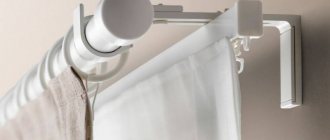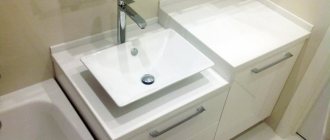Plumbing
0
1 407
Share
It is impossible to imagine a modern kitchen without a sink. And it would seem that what’s difficult about its installation? But installing this equipment yourself raises a lot of questions. There are a number of nuances that affect the quality and speed of installation of a kitchen sink.
The sink and cabinet look like one in the kitchen
- Types of sinks: standard overhead, mortise
- Do-it-yourself equipment installation: how not to forget about the siphon
- Preparing the room and tools for installing a sink into a countertop in the kitchen
- Marking and cutting
- Correct assembly
Rules for installing a countertop kitchen sink
Before starting installation work, you should choose the place where the structure will be built. Usually it is tied to sewerage and water supply. It is possible to embed the device anywhere in the headset. When choosing an installation location, it is advisable to follow these recommendations:
- The bowl is placed as close to the work area as possible, making it more convenient to cook.
- The design divides the work surface into two parts: dirty and clean. In the first, food is processed, in the second, they are served.
- It should not be installed near a stove or refrigerator. It's not practical.
- It is advisable that there be light where the bowl will stand. If necessary, additional lighting is provided.
For a functional kitchen, it is best to choose a deep appliance: you can wash large dishes and other large items in it. A low mixer will give a minimum of splashes during operation.
Installing an overhead sink in the kitchen
How to assemble a sink of this type? Placing it in the right place is quite simple. Initially, the size is selected to match the dimensions of the cabinet where it will be placed, taking into account a small allowance. All work is carried out in several stages:
- Comparison of furniture and sink shapes. If necessary, an outline of the product is drawn on the lid.
- According to the resulting drawing, the base is cut out. In some kitchen sets, sink cabinets are already supplied without an upper ceiling with beams for fastening the structure.
- The cut areas are treated with silicone sealant.
- The mixer is installed.
- The bowl is placed in its proper place, the plumbing is connected and its operation is checked.
Heavy overhead models are installed on self-tapping screws. They come with four or more plates with holes. They are placed on the walls of the cabinet, and the location of the mounting points is also marked there. Five millimeters are retreated from the lower extreme point, a self-tapping screw is screwed in there. When installing the structure, the hardware is tightened until it stops.
What to prepare before installation
For high-quality insertion of equipment into the countertop, in addition to the plumbing fixtures, you need to prepare:
- electric drill and jigsaw;
- Screwdriver Set;
- drill bits;
- pliers;
- square, pencil and ruler;
- fasteners, if they are not included with the device;
- rubber seal;
- silicone sealant.
Need to inspect carefully before purchasing. It should not have any dents or scratches if it is made of stainless steel. If not, you need to additionally check for chips. Even small defects will not allow it to fit tightly to the base, and this is unacceptable. It is optimal that the kit includes good quality fasteners. Otherwise, it is better to purchase them.
Performing markup
Installation is a labor-intensive process that requires special care, as well as certain skills, because even the slightest mistake can ruin both the product itself and the countertop. Therefore, one of the most important stages in the installation work is marking.
There are standard placement rules that should be followed when marking:
- It should be located at least 5 cm (50 mm) from the edge of the tabletop on the front side.
- From the rear end, the distance from the edge of the cut should be no less than 2.5 cm (25 mm), since there is less pressure on the structure from the rear side.
Do not place it near a gas stove, as splashes of water may extinguish the fire.
Designers recommend placing it in the middle between work areas, this will ensure comfortable work. The kit includes a special template printed on the packaging. It needs to be cut out, attached to the tabletop and secured with masking tape, then outlined with a pencil. If there is no template, then the product must be turned over, laid on the tabletop and traced. After drawing the first line, you need to make an indent of 2 mm inward from it and draw a second line - the cutting line. This distance must be strictly adhered to, since if you make it smaller, it will not fit, and if it is larger, then problems with fastening and sealing may arise.
Also, when determining the location for placing the sink on the countertop and marking, it is necessary to take into account the placement of the input and output of plumbing pipes; they must freely approach the central point
Cutting the countertop to fit the size of the sink
You need to cut out a place for it in the countertop. On the marking lines, drill a hole of at least 10 mm using a screwdriver in order to insert a jigsaw file into it. And with the help of a jigsaw, carefully, without jerking and strictly along the intended line, make a cutting.
We check the correctness of the cutting; to do this, you need to insert the shell into the cut hole. If it fits in easily and there is a small gap between it and the countertop, everything is done correctly; if the sink fits in tightly, then additional trimming needs to be done.
The next stage is processing the cut line, for this you need to rub it with fine-grained sandpaper, clean it of dust and shavings and treat the surface with a degreaser, and then with a sealant.
If the countertop is made of moisture-resistant board, it is not necessary to use sealant.
If the structure is rectangular, then cutting a hole for it is very simple, but with a round or irregularly shaped sink, this is more difficult to do, you need to be especially careful and careful
Types of stainless steel sinks
There are many different types of stainless steel sinks on the market today. Their only similarity can only be silver or a similar color. But the shape, dimensions, manufacturing method may differ. And all this affects the work with plumbing in the future, which is why it is important to know all the types and features of models made from the material in question.
Knowing these features, choosing the ideal option will not be difficult. Elegant classics, modern high-tech, ascetic minimalism and cozy country - for each interior there is its own option that will highlight the excellent taste of the hostess.
Stainless steel, as mentioned earlier, is one of the most popular materials for kitchen sinks. It should contain up to 18% chromium and 10% nickel - this will be indicated by the 18/10 mark.
These models are considered the most durable and resistant to mechanical stress and corrosion.
Preparation method
The manufacturing method affects the strength, reliability and durability of the sink. There are few options:
- seamless (stamped) - a seamless sink that is made from a single sheet of metal. Until recently, such sinks could boast a depth of only 15 cm, but today manufacturers also produce deeper models - up to 25 cm. If low-quality material is used, the thickness of the steel may vary - such a defect is noticeable externally, so a thorough inspection of the purchase is important;
- welded - considered the highest quality. They are made from several sheets of metal that are welded together. The seams are then ground and polished; it is their quality that you should look at when choosing a welded sink. Thanks to this technology, a sink can be made of almost any size and shape.
The difference between these types of sinks is not as big as between stainless steel, ceramic or stone, so it is better to pay a little more for a welded one, but use it much longer.
Surface
The surface of the sink may also vary. The most popular classification is matte/glossy. The peculiarity of matte ones is that they can have different textures, for example, imitate fabric, but you will have to pay for this ability. The advantage is that scratches, stains and drops are practically invisible on such a surface.
Glossy ones, in turn, can also be decorated with relief patterns. Even in the absence of such patterns, maintaining the gloss is more difficult, since traces of drops and small scratches immediately become visible on them. But such a surface is easier to clean from plaque.
The relief and texture on the sink is, of course, beautiful, especially if combined with a table or countertop. But this is not practical, since cleaning these reliefs from traces of dried drops is problematic.
Installation method
The installation method often depends on what is under the sink - a cabinet or a countertop. Outside options differ in appearance, so often the choice is based on appearance.
| Invoice | How a lid on a jar is installed on a cabinet without a top. This is the simplest and most cost-effective option for installing a stainless sink. They are easy to care for, but they will not last as long as their counterparts. |
| Mortise | To install such a sink, you need to make a hole in the countertop of a suitable size. Next comes fastening either to brackets or to regular sealant. Sometimes a rubber seal is placed at the junction points. |
| Integrated (recessed) | Typically, recessed sinks are not made of stainless steel, since this is a more expensive price segment. For such a sink, a countertop made of solid wood or chipboard is not suitable - only stone (natural or artificial) or plastic. |
Number of bowls and wings
The variety of conventional stainless steel sinks is amazing. Nowadays you can find a sink with 1, 2, 3 or even 1.5 bowls. The last option means that there seems to be a bowl, but it is very small - for drying several fruits or cutlery. The most professional - three-section - includes two large compartments and one small one. Often such models are used in restaurants and cafes.
Two bowls are necessary if you want to make two zones independent of each other. Typically, the second bowl of a double sink is used for defrosting food or storing dirty/clean dishes for drying.
It is worth noting that the housewife may only have plans for an additional bowl, and household members may constantly put dirty dishes there because it is convenient.
If there is a dishwasher in the kitchen, then we can say with almost one hundred percent certainty that a 2-section sink will not be required. But there is another very useful invention - wings. The wing is a flat extension of the shell made of the same material.
Wings at the sink can be useful during cooking, for example, putting washed vegetables or frozen meat there to defrost. You can also place a hot frying pan on the wing or put all the freshly washed glasses that guests left behind there.
If the kitchen is large, then most often they choose a two-section sink with one wing or a single sink with two wings. For a small kitchen, the best option is a single-section sink with one wing.
There are reversible sinks and non-reversible ones. This concept is connected precisely with wings. If the sink has only one wing, and you can place it on both the right and left by simply turning the sink around, then it is called a reversible sink. If the wing can only be on one side, then it is non-reversible.
Form
Kitchen sinks can be either standard or the most bizarre shapes. Modern technologies can bring designers' wildest fantasies to life, taking into account the advice of kitchen ergonomics experts.
The classic version is square or rectangular. Round specimens are also often found, but they do not reach the first place of sale. Triangular or oval bowls are much less in demand.
Choose the shape of the sink according to your convenience. For example, with equal volume, round sinks are considered the most spacious compared to other shapes. This is due to the lack of corners in which it is difficult to place something.
Thanks to this lack of corners, caring for such a sink is greatly facilitated.
In addition, it is important to ensure that the shape of the sink fits into the overall interior of the kitchen. For example, if the design uses only straight, strict lines, then it is better to abandon the oval sink in favor of a square or rectangular one.
The following possible forms are distinguished.
| Square/rectangle | A classic that will fit into any interior and set. They look most impressive not in the corner, but in the center of the kitchen. Spacious, convenient to wash dishes. |
| Circle/oval | Looks stylish. Due to the lack of corners, it is a little more spacious and easier to care for. Rarely found with additional bowls. Maximum - one wing. |
| Angled/Trapezoidal | They save space, so they are considered an excellent option for a small kitchen |
| Pentagonal/hexagonal | Modern models formed by additional sections and wings. The sinks are very functional and spacious. Mounted both in the corner and along the wall. Suitable for large kitchens only. |
Corner and trapezoid are most often used in corner sets. Such forms help save space while organizing a comfortable work area in the corner.
Decorative coating
In expensive models you can find an additional decorative coating, which also has protective properties. It's called PVD coating. Can give stainless steel different effects:
- bronze;
- gold;
- brass;
- old silver
This will allow you to use stainless steel even in those interiors where chrome shine is out of place, for example, in classic or country style kitchens. For such beauty you will have to pay from 8–9 thousand.
Another option for decorating a stainless steel sink is glass. The bowl itself is made of metal, and 8 mm thick tempered glass is placed on top (around and on the wing). Usually it is white or black. Such beauty costs several times more. For example, for the Chinese manufacturer Oulin you will have to pay about 40 thousand rubles, and for the popular Blanco and Franke - under 100 thousand rubles.
Fixation methods
Depending on the material, it can be fixed with glue or fastening materials, but it is better to use these means together.
Glue is more suitable for fastening stainless steel products; this method will allow you to securely fasten the sink to the countertop, but only with the correct fit. Before the gluing process, you need to prepare the surfaces and apply a special polyethylene sealant. We coat the places of future fastening with glue, press it well, it can be used only after 24 hours.
Fastening materials are a more reliable method of fastening, but it must be combined with glue to prevent water from entering at the screw fastening points.
It is better to fix the fasteners using a screwdriver rather than a screwdriver, so as not to damage the product. You need to tighten the screws one by one, checking the fit.
Rules for connecting to communications
After completing the work of attaching the sink to the countertop, you can begin connecting it to the communications.
- Securing the cold and hot water supply hoses - on one side to the mixer, on the other - to the water tap. When connecting, we use rubber gaskets to seal the joints.
- Release the siphon and discharge it into the sewer pipe.
- Check all connections for leaks and install additional seals if necessary.
If the diameters of the siphon and sewer pipes differ in size, then a special sealing cuff-adapter can be used to securely fasten them
Professional advice on installing sinks: what to look for
Experienced installers share the following secrets of their work:
- When installing a mortise sink yourself, you need to check the dimensions of the hole several times. It should not be too large, otherwise it will “walk” in the groove, and the fastenings will not provide the required strength.
- When installing a stainless steel sink, do not over-tighten the screws. This may cause damage.
- Instead of the seals that come with the kit, you can use sealant. You shouldn't save it. It’s easier to carefully remove excess than to deal with leaks later.
- When using a screwdriver or a screwdriver, it is important to be careful not to bend the hardware.
.
Pros and cons of stainless steel sinks
Among the advantages of metal structures are noted:
- Resistance to loads and impacts. High-quality products can easily withstand the weight of pots filled with water and a large number of dishes.
- They tolerate high temperatures well, so you can put hot objects in stainless steel bowls, if necessary, and pour boiling water into them.
- A stainless steel sink fits perfectly into kitchen units of any style. Metal goes well with many materials - wood, artificial and natural stone, plastic and glass.
- Stainless steel sinks are easy to clean. Special products are used to wash them - they extend their service life and allow you to keep the surface in its original form for a long time. After each use, it is advisable to wipe the bowl dry so that no traces of drops remain.
- Sinks made of this material are designed for long-term use - for one or two decades. But this can only be achieved if you properly care for the product.
- Stainless steel sinks are more affordable than ceramic and stone models. The price depends on the method of production and configuration, finishing option.
But such sinks also have a number of disadvantages :
- Over time, scratches will inevitably form on the surface. It is difficult to avoid contact of the product with sharp objects.
- Typical stainless steel sinks are always noisy. If you drop an object into them, everyone in the apartment will hear it. There is also a high noise level when washing dishes, when water hits a metal surface. To avoid this, some manufacturers line their models with an additional layer of rubber or increase the thickness of the steel. But along with this, the price of the product also increases.
- The main disadvantage of stainless steel sinks is the limited selection of shades and colors. In some cases, you can find options in the color of gold, brass and other metals.
Installation features
We install a corner sink.
Sawing a right angle. In order for an electric jigsaw to easily pass through the corners of the tabletop, several holes are first made in them with a drill, one after another, and they are combined. You should also pay attention to the fact that the corners and connecting lines of the inner and outer corners of the cabinet coincide.
We cut in a square sink.
Installing a sink into a countertop begins with drawing a line that runs parallel to the edge of the countertop. Then make an indent to the width of the sink and draw a second line. In a similar way, two perpendiculars are measured and laid. Mark the intersection point of the segments that connect opposite angles. The siphon is located in this place.
Installing a stone sink
Sinks made from natural stone, such as granite, do not have faucet or drain holes. The first can be mounted separately to a tabletop or adjacent wall. And it is impossible to do without a siphon.
Carefully making such a hole in a natural stone sink yourself, without sufficient knowledge and experience, is a very difficult task. For this you need an electric drill with diamond bits. For this reason, it is better not to install granite products yourself, but to trust specialists.
Types of sinks: standard overhead, mortise
Before proceeding with installation, let's decide on the type of equipment. Each type of sink differs in the order of installation and operation. The entire range on the market is divided into the following models:
- Invoices. Inexpensive and easy to install kitchen sinks. They are installed directly on the cabinet and replace the tabletop. Among the disadvantages are the low aesthetic indicators of this design and the gaps formed due to the loose fit of the sink.
- Mortise. This variety got its name based on the specifics of the installation. The kitchen sink cabinet is processed, a hole is cut in it, into which the equipment is mounted. The design is uniform, durable and practical. Please note that mortise sinks are installed at countertop level. Constant contact with water, inevitable when washing dishes, negatively affects the work surface. Because of this, the tabletop gradually deforms. To avoid this, thoroughly wipe the surface after finishing working with water.
- Under-table. These sinks are specially designed to sit below countertop level when installed. Thanks to this, a high level of geometrization during installation is ensured, allowing to avoid water getting on the working surface. This kitchen sink with cabinet is installed in countertops made of stone, hardwood and glass.
- Integrated. This type is combined with a work surface, forming a single structure. Moreover, the side of such a sink can be located at any level in relation to the countertop. Installation of integrated models takes a long time, is labor-intensive and expensive.
Which type of equipment to prefer from those presented is an individual decision for everyone. It depends on the customer’s taste, budget and furniture set. A cabinet with a sink for a kitchen of overhead and mortise type are the most common options. They represent the optimal combination of price and quality. Invoices are used as temporary equipment. Mortise models - for sectional furniture with a single tabletop.
Selecting a sealant
The sealant plays an important role in installation. The building materials market offers several options for this product:
- acrylic - does not contain harmful substances, is excellent for metal, chipboard and MDF, dries quickly. The main disadvantage is strong shrinkage and rigidity; joints can crack over the years and will allow water to pass through;
- polyurethane - suitable for places with high humidity and unstable temperatures, good adhesion to almost all materials. The sealant is elastic and practically does not shrink, but it is better not to use it for MDF, chipboard, or plastic. The polyurethane composition is ideal for products made of stone, granite, metal;
- silicone - elastic, does not shrink, good adhesion.
Apply any sealant to clean materials to improve adhesion. Without preliminary preparation, cracks may appear and moisture may enter.
Possible mistakes
Mistakes are often made that lead to undesirable consequences. People often save space by not taking into account the requirements for the distance between the sink and other equipment, which should be at least 40 cm. There are also other miscalculations:
- incorrect choice of kitchen sink size;
- tilting of the installed sink - occurs if you work without a level;
- incorrectly selected pipes and siphon;
- poor access due to inconvenient location;
- insufficient sealing during mortise-type installation;
- poor-quality fixation of fastening parts, which leads to mobility of plumbing fixtures;
- water penetration under furniture.
To eliminate errors and correctly perform the process yourself, watch the video, which describes in detail the work processes and all the intricacies of mortise-type installation:
Installing an undermount sink in the kitchen.
We recommend that you monitor your sink and provide it with the necessary care. After each dishwashing, you should wipe the product dry and do not place hot or very cold surfaces. The appearance of an unpleasant odor and leaks requires inspection of the siphon, pipes and mixer - cleaning may be required. If parts are damaged, they are repaired or completely replaced.
General information
Installing a sink in a kitchen has some peculiarities, the main one of which is that wall-hung plumbing is not used in this room. Therefore, sinks are installed with cabinets, and according to the installation method they come in two types:
| Invoices | A cabinet without a countertop is used for this plumbing fixture. A sink is installed instead. |
| Mortise | In this case, a cabinet with a countertop is used, in which a hole is cut to fit the size of the sink. |
Countertop sink
The installation of such plumbing fixtures is simplified by the fact that there is no need to fix the product to the wall. In addition, the installation height of the sink from the floor has already been determined by the furniture manufacturer.
Therefore, the work comes down to several stages:
- Assembling the structure;
- Installing the cabinet in a permanent location;
- Installing a sink on a cabinet;
- Connecting the siphon to the sewer and the mixer to the water supply.
Below we will take a look at all these stages.
Mixer installation











